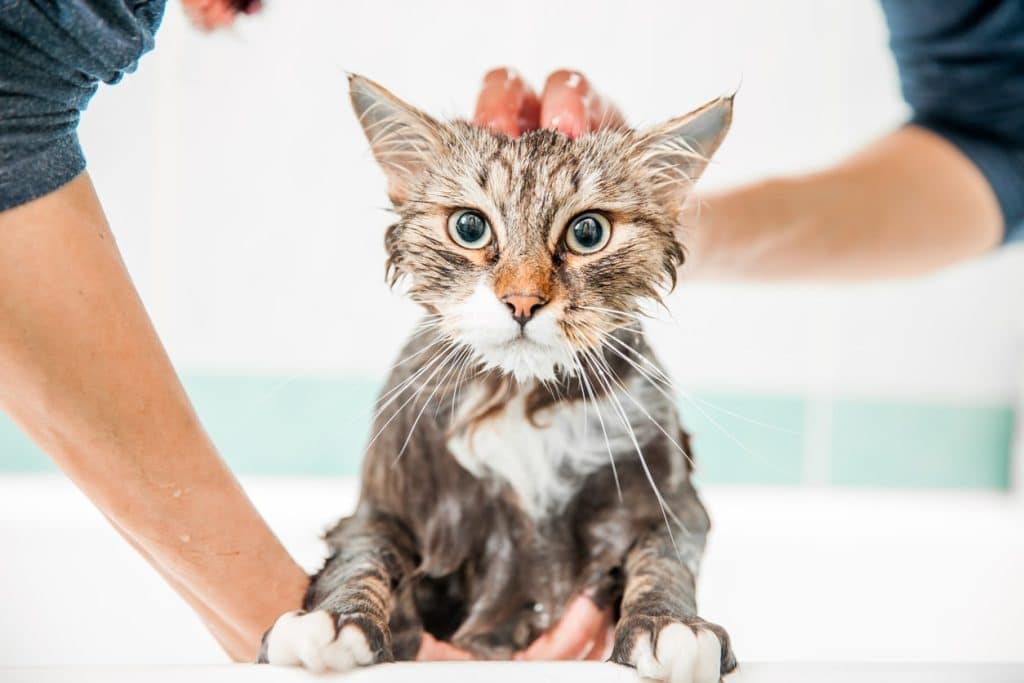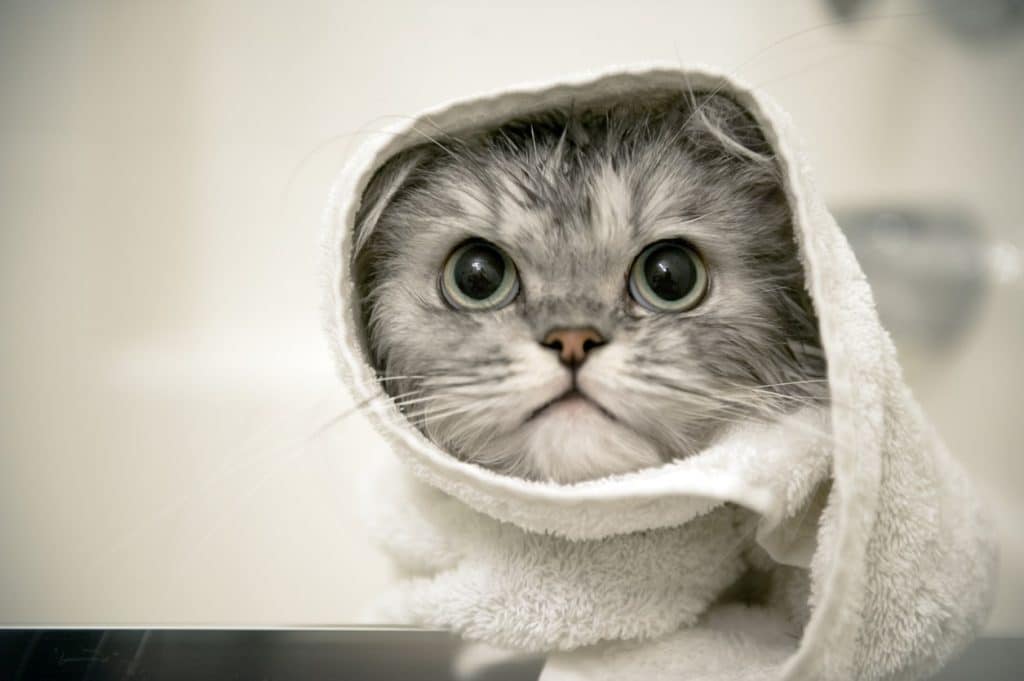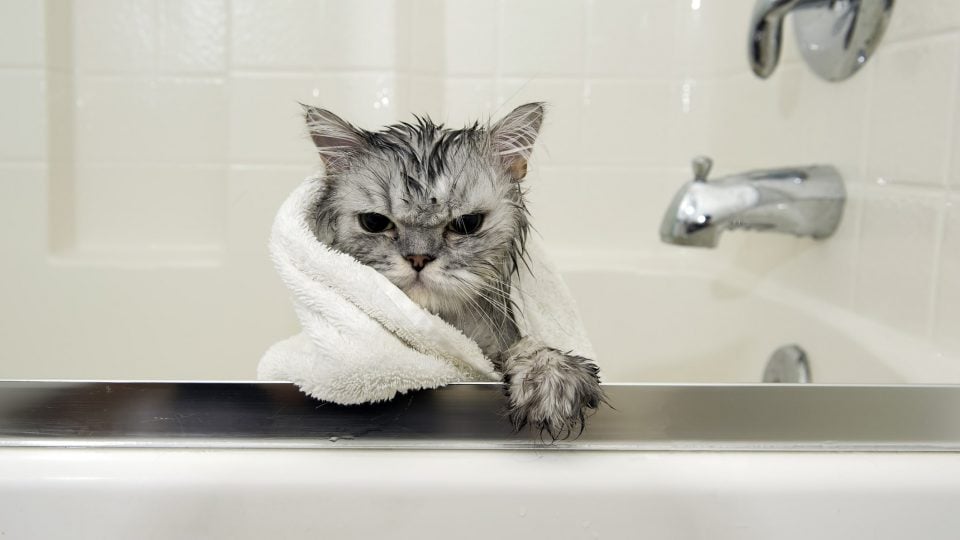Our feline friends are usually unphased by what they encounter in their ordinary day-to-day lives…until water enters the equation. Nothing else can strike fear into the hearts of cats and their caregivers like water and bathtime. Thankfully, unlike dogs, most cats don’t need baths, says vet Dr. Amber Carter. “Cats are excellent groomers and generally take care of keeping themselves clean.”
Equipped with scratchy tongues with sharp bumps and impressive flexibility, many cats can easily tackle excess hair, dirt, and grime accumulating in their fur. However, it might be necessary to bathe a cat if they have the following:
- Medical issues
- Skin conditions
- Specific fur types
- Exposure to toxic substances
During a bath, always keep an eye on your cat and slowly clean them using gentle cat-safe cleansers and slow movements.
Below, experts explain everything you need to know about cat bathtime, what to avoid when bathing a cat, and how to make bathtime as stress-free as possible.
Do Cats Need Baths?
While cats are notorious for cleaning themselves, in some situations, feline hygiene calls for a human hand. Dr. Carter says medical conditions and illnesses that require regular bathing include:
- Neurological conditions
- Hindlimb paresis
- Bladder disorders and diseases
- Obesity
- Incontinence
- Fungal infections
- Flea infestations
- Arthritis
For some skin conditions, medicated shampoos are prescribed with topical treatments. Cats with fungal infections such as ringworm benefit from a combination of baths with anti-fungal shampoos and topically applied medications. Flea infestations are also best targeted with flea preventatives and baths. Antibacterial washes prescribed by your cat’s vet can help treat and eliminate feline chin acne.
How Often Should You Bathe A Cat?
How often to bathe a cat varies. To reduce bath-associated stress for your cat, Dr. Carter suggests mini-baths focused only on your cat’s soiled areas instead of fully submerging them in water.
Laura Cassiday, Certified Cat Behaviour Consultant and founder of Pawsitive Vibes Cat Behavior & Training, also says long-haired breeds like Persians and Birmans and hairless breeds like Sphynx need more baths than the typical mixed breed domestic short-haired cat.
“Sphynx’s need bathing as frequently as once a week,” Cassiday says, “They may not shed, but they will leave oily brown stains all over your home if they haven’t been bathed recently!”
Where Should I Bathe A Cat?
Bathtubs are the best place to bathe your cat, says Joey Lusvardi, Certified Cat Behaviour Consultant and founder of Class Act Cats. They are more spacious than sinks and buckets, and because bathing a cat is often a two-person job, this larger space is the most fuss-free way to wash your cat.
Also, Lusvardi says bathtubs allow you to fill the tub part of the way with water while leaving one end of the tub dry, combatting your cat’s stress around bathtime before it can start. “This allows your cat to choose if they want to sit in the water or on the dry end,” he explains.
Dr. Carter says the size of bathtubs makes it easier for one person to hold your cat and the other to wash them, using hands and a cup to gently wet and lather parts of your cat’s body.
Cassiday agrees and adds, “A good trick I use is to face the cat towards the wall and place their front paws on the ledge. That way, teeth and claws are facing away from you!” Closing the bathroom door is also a perk and can keep your cat from bolting out of the bath and fleeing.

iStock/CasarsaGuru
How to Prep a Cat for a Bath
Cassiday says it’s best to train cats as young as possible to associate with baths, ideally in kittenhood, positively. Positive reinforcement can help your cat learn that a bathtub is a safe place and that baths predict good things.
Cassiday recommends the following steps to prep your cat for bathtime:
- Step 1: Bring your cat into the bathroom and feed them treats on the floor
- Step 2: Bring your cat into the bathroom and feed them treats in an empty tub
- Step 3: Bring your cat into the bathroom and feed them treats in a damp tub
- Step 4: Bring your cat into the bathroom and feed them treats in a tub with ½ inch of water
Cassiday says patience is essential and to repeat steps multiple times before moving on.
11 Cat Bathtime Essentials
The easiest way to reduce stress during bathtime is to get your supplies ready ahead of time.
Dr. Carter, Cassiday, and Lusvardi say to bathe your cat, pet parents should have the following items:
- Cat-specific shampoo
- Non-slip rug or yoga mat
- Cup
- Washcloth
- Cotton balls
- Artificial tears
- Soft, warm towels
- Cat-specific comb or brush
- Lickable treats
- Cat-safe wipes for smaller areas like paws and around (not in) ears
- Cat-safe conditioner
How to Hold a Cat During a Bath
Dr. Carter says the most important thing when you hold a cat during a bath is not to “scruff” them. If your cat is panicking and struggling, Dr. Carter says to stop immediately and ask your vet for advice.
While bathing your cat, Dr. Carter suggests going slow and keeping your cat close to your body with a hand on them throughout the process. Lusvardi agrees and suggests using low-stress handling techniques like touch gradient. Touch gradient “prevents cats from going through the stress of having that initial touch happen repeatedly.”
Luckily, touch gradient isn’t a complex process. Lusvardi says cat caregivers can achieve it by:
- Getting the washcloth wet
- Washing part of your cat that’s going to be less stressful for them, such as their back
- Moving slowly while washing a less-pleasant area on your cat, such as their belly pouch
- Taking frequent breaks to allow your cat to decompress and avoid stress build-up

iStock/kevinjeon00
How to Bathe Your Cat in 7 Simple Steps
After giving your cat toys, trimming their nails, and brushing out extra hair, here are seven cat-behaviourist-approved steps for bathing your cat from Lusvardi and Cassiday:
- Wear clothing you don’t mind getting wet, and gather your supplies. Place towels and non-slip rugs or yoga mats down and close the bathroom door
- Fill the bathtub with 3 to 4 inches of warm water, leaving one end of the tub dry. Test the temperature to make sure it’s not too hot, then squirt shampoo into the water and stir it in until the water is bubbly
- Using low-stress handling techniques (NO scruffing) to place your cat into the bathtub gently
- Use a small cup to wet the areas of your cat that need to be washed
- Using a washcloth dipped in warm, shampooed water or cotton balls for more delicate areas, gently wash your cat– using touch gradient if needed
- Rinse the sudsy, washed areas with a cup (or cups) of fresh, unsoapy water
- Gently towel dry your cat, soaking up as much water as possible, then let them air dry
“Don’t be afraid to use the power of treats to help keep your cat in a positive mood,” Lusvardi says.
How to Keep Your Cat Safe During Bathtime
Cat safety is essential during bathtime. Since cats don’t like water, they might squirm around, putting them (and you) in an unsafe situation.
Cassiday, Lusvardi, and Dr. Carter recommend these strategies to keep your kitty safe.
- Use cat-safe, unscented shampoo
- Roll out a non-slip mat to prevent falls and injuries
- Clip your cat’s nails ahead of time to reduce the severity and likelihood of being scratched
- Recruit a second person to help—one person can hold the cat while the other can wash
- Avoid getting shampoo or water in your cat’s eyes
- Keep the bathing area as quiet and peaceful as possible
- Don’t spray cats with shower heads or hoses to avoid activating their fight or flight instincts
- Use a cotton ball to clean small areas, like your cat’s face
- Go slow and give your cat plenty of breaks during the bathing process
- Use feline pheromones to reduce your cat’s stress and anxiety
- Stop ASAP if your cat starts to panic
Lusvardi says hiring a professional groomer is the way to go for cats who are very distressed by home bathing.



